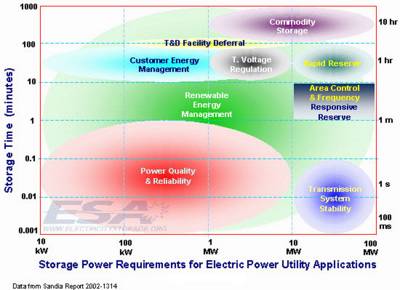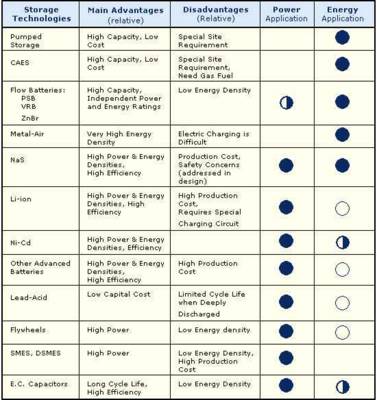September 30, 2004
Problems of Electricity Storage
The storage of electrical energy is an important problem, more or less as old as the use of electricity itself.
I think it is important to make a distinction, to begin with.
Energy is defined as the capacity of performing work (like moving objects around). Its unit is Joule (J), defined as the energy required to move a mass of 1 kg for 1 m against a force of 1 N.
Power is the amount of energy produced in a certain time. Its unit is Watt (W), defined as 1 Joule per second (1 W = 1 J/1 s). 1 kWh, the unit most often seen in electricity applications, is actually a measure of energy (equal to 3.6 MJ).
Thus, if we have a source full with say, 10 MJ of energy, it will power a 100 W lamp for a little more than one day, or a 2000 W electric heater for an hour and half (all this without taking into consideration losses, physical limits and the fact that often power sources cannot exceed a certain power level without damage).
Our world depends on electricity. Internet, maybe the most revolutionary communication and data excange medium, depends heavily on electricity, and the same is true for domestic appliances and a long list of devices. But having some electricity is not sufficient; we need quality and reliable power. Quality means that the electricity available at our sockets must meet quite tight specifications of voltage and frequency, otherwise the appliances will not work properly, and may even be damaged. Reliable means that power must be available 24/7, go off only rarely - only in case of exceptional bad weather or other very serious events. Think of companies, of network and web servers that must remain online as much as possible. Or factories, with long and complex production lines, or medical machines in hospitals, and telephone lines and nodes. All these applications need backup power, to overcome eventual grid failures. A loss of power can cause loss of data, loss of communications, loss of products or loss of life. A tomato processing factory where I worked, had big diesel generators ready to start automatically in case on power loss from the grid - and tomato processing does not pose particular hazards.
I think it is important to make a distinction, to begin with.
Energy is defined as the capacity of performing work (like moving objects around). Its unit is Joule (J), defined as the energy required to move a mass of 1 kg for 1 m against a force of 1 N.
Power is the amount of energy produced in a certain time. Its unit is Watt (W), defined as 1 Joule per second (1 W = 1 J/1 s). 1 kWh, the unit most often seen in electricity applications, is actually a measure of energy (equal to 3.6 MJ).
Thus, if we have a source full with say, 10 MJ of energy, it will power a 100 W lamp for a little more than one day, or a 2000 W electric heater for an hour and half (all this without taking into consideration losses, physical limits and the fact that often power sources cannot exceed a certain power level without damage).
Our world depends on electricity. Internet, maybe the most revolutionary communication and data excange medium, depends heavily on electricity, and the same is true for domestic appliances and a long list of devices. But having some electricity is not sufficient; we need quality and reliable power. Quality means that the electricity available at our sockets must meet quite tight specifications of voltage and frequency, otherwise the appliances will not work properly, and may even be damaged. Reliable means that power must be available 24/7, go off only rarely - only in case of exceptional bad weather or other very serious events. Think of companies, of network and web servers that must remain online as much as possible. Or factories, with long and complex production lines, or medical machines in hospitals, and telephone lines and nodes. All these applications need backup power, to overcome eventual grid failures. A loss of power can cause loss of data, loss of communications, loss of products or loss of life. A tomato processing factory where I worked, had big diesel generators ready to start automatically in case on power loss from the grid - and tomato processing does not pose particular hazards.
Storage systems come in our help, as they make it possible to store electricity to be used when the need arises. This is the field "Power Quality&UPS", designed to erogate up to 100 MW (that's a goddamn huge UPS!) for times of a few minutes. If the power and discharge times are higher, it's the field of "Bridging Power" - basically, while we wait for the grid to be restored, or our backup generator to come online (up to now, an internal combustion generator is still the very best way to assure electricity availability...).
It's quite evident from the chart that there are many technologies available for powers up to 1 MW and discharge times of hours - thus, our needs of UPS and bridging power in that range can be fully satisfied. Batteries can still save the day for powers up to 100 MW (you'll need a whole warehouse full of batteries, for that). But what if we want to store the electricity produced by solar cells during the day and use it at night? This is the field of energy management. Batteries have a small role in it, and the only serious offers are pumped hydro - pumping water in a basin uphill, and later use this water to drive turbines, and Compressed Air Energy Storage (CAES), that uses high-pressure air stored underground to drive a gas turbine, with a great economy of fuel - because an atmospheric pressure turbine uses much of the fuel to compress air in the first stages.
Figure 2 is a summary of the power and time requirements for various applications. PQ&R takes a considerable area, but Renewable Energy Management spans almost the whole space... however, it is centered on megawatts for minutes. I somewhat disagree with this choice, but I trust the experts who made it. Other important applications of energy storage are in the stabilization of electricity transmission systems: great and sudden variations of load on the system can cause cascading failure leading to a wide-area black out. A storage system can be kept empty to "absorb" eventual excess energy, and another can be kept loaded in order to replenish an energy deficit.
All this is nice and good, but what about the practical implementation of these systems?
As usual, reality if often sadder than theory. Other factors besides the technological possibilities must be considered, like capital cost, efficiency, size and weight, life cycle etc. All considered, it emerges that some storage systems are suitable for certain applications, and other systems for other applications. This is not surprising, but I noticed that some people not acquainted with engineering struggle to grasp even this simple concept.
There are two things to notice: one, apart from pumped hydro, and maybe CAES, there is no mention of methods to store electricity for long periods of time, days or more. One might load a battery and use it days later, but spontaneous discharge will consume part of the stored energy, and I suspect that parasite chemical reactions would compromise the efficiency of the various types of flow batteries - if not damage the battery itself.
Two, the environmental problems (scary music in the background). You know, there is nothing that can really satisfy the grassroots enviro-ignoramentalists. Batteries contain nasty (relatively) chemicals, and take a lot of space (low energy density, as kJ per m3 of battery*); pumped hydro needs something horrible like a dam, or a big hole. CAES... are you really so crazy to put high-pressure air underground?? That will blow up our children and our trees!
And so on and on, ad infinitum.
However, some of the environmental concerns are real: the disposal of old batteries and/or the chemicals they use is not a trivial task, and it must be examined properly. I think the best solution would be to implement a closed-loop system, where the battery factory will also take care of the disposal of old batteries, and possibly recycle as much as possible of them. Of course is not proponible to discard the spent electrolite solutions from flow batteries as toxic waste.
* Initially I wrote "kW/m3, but then I realized I feel in the old energy-power trap: energy is expressed in Joules.
Comments:
Post a Comment






